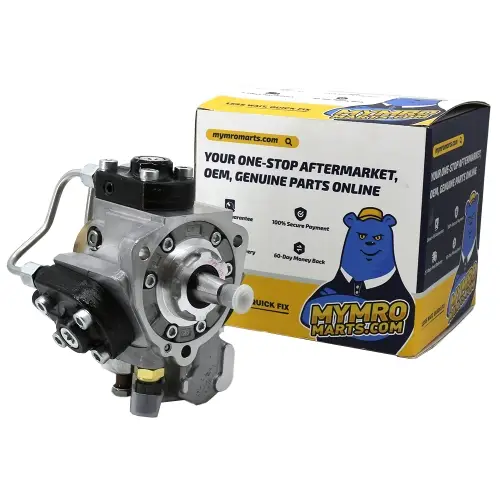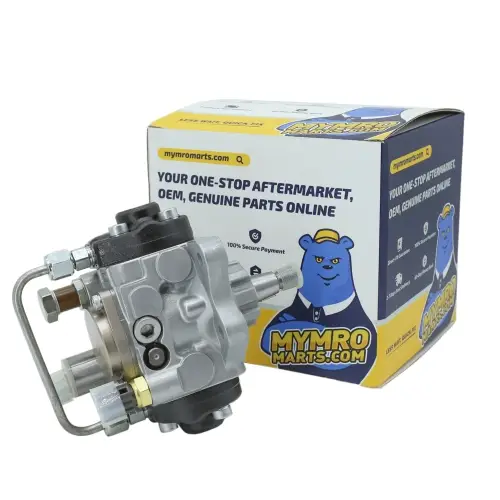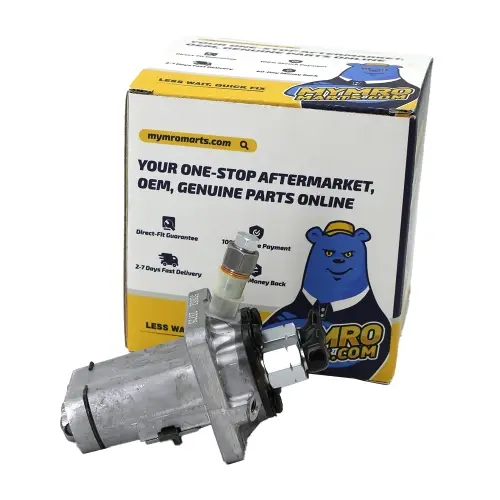What Is A Fuel Injection Pump And How Does It Work?
Fuel injection pump technology is crucial to current internal combustion engine technology. It is essential to the effective functioning of the diesel engine in addition to being its central part. To guarantee the operation of heavy machinery and increase engine longevity, it is crucial to comprehend the fuel injection pump's functioning principle and appropriate maintenance techniques. This article from MyMROmarts teaches readers how to properly maintain and care for fuel injection pumps while delving into their secrets. Next, MyMROmarts will first introduce the fuel injection pump working principle and function of the injection pump.
What Is A Fuel Injection Pump?
Diesel is pumped into the engine using a fuel injection pump. High pressure compressed air is forced into the combustion chamber by the pump, which also injects fuel and applies pressure. To maximize the power, economy, and fuel consumption of your heavy equipment, the diesel fuel injection pump guarantees optimal fuel supply and calibration. The majority of buyers of diesel fuel injection pumps do so in order to optimize their fuel usage and increase the pulling capacity of their trucks or tractors. As such, what is an injector pump and why is it so important? The fuel injection pump is the engine's central component and should be of the best caliber to guarantee a long and effective engine life.
Fuel Injection Pump Working Principle
The working principle of the fuel injection pump is simply to drive the plunger through the cam on the camshaft, thereby sucking in fuel, pressurizing it, injecting it into the engine cylinder, and finally returning the uninjected fuel to the low-pressure oil chamber to form a cycle. Below is a detailed explanation of how does a diesel injector pump work:
Oil Absorption Process
The plunger is driven through a cam on the camshaft by the fuel injection pump. Under the force of the plunger spring, the plunger descends when the convex portion of the cam leaves it. A low-pressure oil chamber is produced when the oil chamber's volume grows and its pressure drops. The fuel in the low-pressure oil chamber flows into the pump chamber along the oil inlet hole when the pump's radial oil intake hole is uncovered.
Pressurization Process
The pressure rises and the pump chamber's volume shrinks as the convex part of the cam forces the plunger higher. At this point, the pressure in the pump chamber rapidly rises as the fuel is pushed to return to the low-pressure oil chamber through the radial oil hole on the plunger sleeve. The delivery valve opens when the pressure is greater than the tension exerted by the delivery valve spring. Pumped into the high-pressure oil line, high-pressure diesel is ready for injection through the injector into the engine cylinder. This process demonstrates how does an injector pump work under high-pressure conditions.
Oil Return Process
The fuel in the pump chamber returns to the low-pressure oil chamber through the plunger's axial oil route as the plunger continues to rise and its chute is attached to the radial oil hole on the plunger sleeve. The cycle is over, the fuel injection pump shuts off, and the oil channels and oil holes on the plunger sleeve return to the low-pressure oil chamber.
How To Maintain The Fuel Injection Pump?
Proper Maintenance Of Fuel Injection Pump Accessories
The accessories of the fuel injection pump include the pump body side cover, oil dipstick, fill plug, oil overflow valve, oil sump plug, oil level screw, fuel injection pump fixing bolt, etc. They play a vital role in the operation of the fuel injection pump. For example, side covers prevent the intrusion of impurities such as dust and water. A breather (with filter) can effectively prevent oil deterioration. The oil spill valve can ensure that the fuel system has a certain pressure so that air does not enter the fuel tank. Therefore, it is necessary to strengthen the maintenance of these accessories. Once damaged or lost, they must be repaired or replaced in time.
Regularly Checking The Oil Quantity And Quality Of The Oil
Before starting the diesel generator, the oil quantity and quality in the fuel injection pump should be checked (except for the fuel injection pump that is forcibly lubricated by the engine). Suppose the engine oil has gone bad due to mixing with water or diesel. In this case, early wear of the plunger and oil delivery valve will occur, resulting in insufficient power of the diesel engine and difficulty in starting. Worse yet, deteriorating engine oil can cause corrosion of the plunger and delivery valve assembly.
Internal leakage of the oil pump, poor operation of the oil delivery valve, wear of the fuel pump tappet and casing, damage to the sealing ring, etc. will cause diesel to leak into the oil pool and dilute the engine oil. Therefore, it should be replaced in time according to the quality of the oil. Before replacement, clean it thoroughly to remove sludge and other impurities at the bottom of the oil pool, otherwise, the new oil added will quickly deteriorate again.
The amount of oil should be just right. Too much oil in the governor can easily cause the diesel engine to "run away". In addition, when the diesel engine is not used for a long time, be sure to check whether there are impurities such as water and diesel in the oil pool of the oil pump. If so, replace it immediately. Otherwise, due to long-term storage, water can easily cause parts such as the plunger and oil delivery valve to be corroded or stuck, leading to scrapping.
Regularly Check And Adjust The Oil Supply Of Each Cylinder
Because the plunger coupling and the oil delivery valve coupling are worn, internal leakage of diesel fuel will reduce or make the oil supply to each cylinder uneven. This results in difficulty in starting the diesel engine, insufficient power, increased fuel consumption, and unstable operation. Therefore, it is necessary to regularly check and adjust the fuel supply volume of each fuel injection pump cylinder to ensure the power of the diesel engine. By observing the exhaust of the diesel generator, listening to the sound of the engine, and touching the temperature of the exhaust manifold, the fuel supply amount of each cylinder can be determined.
Using Standard High Pressure Tubing
During the oil supply process of the fuel injection pump, due to the compressibility of diesel and the elasticity of the high-pressure oil pipe, the high-pressure diesel will form pressure fluctuations in the pipe, and it takes a certain time for the pressure wave to transmit in the pipe. Even, the diesel engine works smoothly, and the length and diameter of the high-pressure oil pipe are selected through calculation. Therefore, when the high-pressure oil pipe of a certain cylinder is damaged, it should be replaced with a standard length and diameter oil pipe. In fact, due to the lack of standard oil pipes, other oil pipes are used instead, regardless of whether the length and diameter of the oil pipes are the same, so the length and diameter of the oil pipes vary greatly. The quantity changes, resulting in the unstable operation of the whole machine, so the standard high-pressure oil pipe must be used.
Ensuring High Cleanliness Of Diesel Fuel
In general, diesel generator filters need far more filters for diesel oil than gasoline engines need for gasoline. When using it, make sure the diesel oil you use is graded correctly, maintain and clean your diesel filters thoroughly, and replace or clean your filter components on schedule. Make sure the diesel tank is thoroughly cleaned to get rid of any water and sludge at the bottom, taking into account the working environment circumstances. Any contaminants in the diesel will seriously corrode or wear out the fuel injection pump's plunger, the fuel delivery valve's coupling components, and the transmission parts.
Checking The Camshaft Clearance Regularly
The axial clearance of camshafts of the fuel injection pump is very strict, generally between 0.03 and 0.15mm. If the clearance is too large, the impact of the roller transmission parts on the working surface of the cam will be aggravated, thereby increasing the early wear of the cam surface and changing the oi supply advance angle. When the axial clearance of the camshaft is too large, it can be adjusted by adding gaskets on both sides. If the radial clearance is too large, it is generally necessary to replace it.
Checking The Sealing Condition Of The Valve Couple Regularly
After the fuel injection pump has been working for a period of time, by checking the sealing condition of the oil outlet valve, a rough judgment can be made on the wear of the plunger and the working condition of the oil pump, so as to determine the repair and maintenance methods. When checking, unscrew the high-pressure oil pipe joints of each cylinder, and use the oil delivery pump to pump oil from the oil pump. If oil flows out of the oil pipe joint on the top of the fuel injection pump, it means that the oil outlet valve is not well sealed (this will also happen if the oil outlet valve spring is broken). If there is poor sealing of multiple cylinders, the fuel injection pump should be thoroughly debugged and the valve couple should be replaced.
Consequently, it is essential to comprehend the fuel injection pump's operation and to carry out routine maintenance and inspections. Together with ensuring the diesel engine runs normally and produces the desired amount of power, it may also save maintenance expenses and maximize the engine's service life. Your driving experience will be smoother if you remember the proper maintenance procedures and take good care of the "heart" of heavy machinery.
 Track Your Order
Track Your Order








